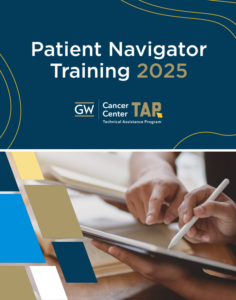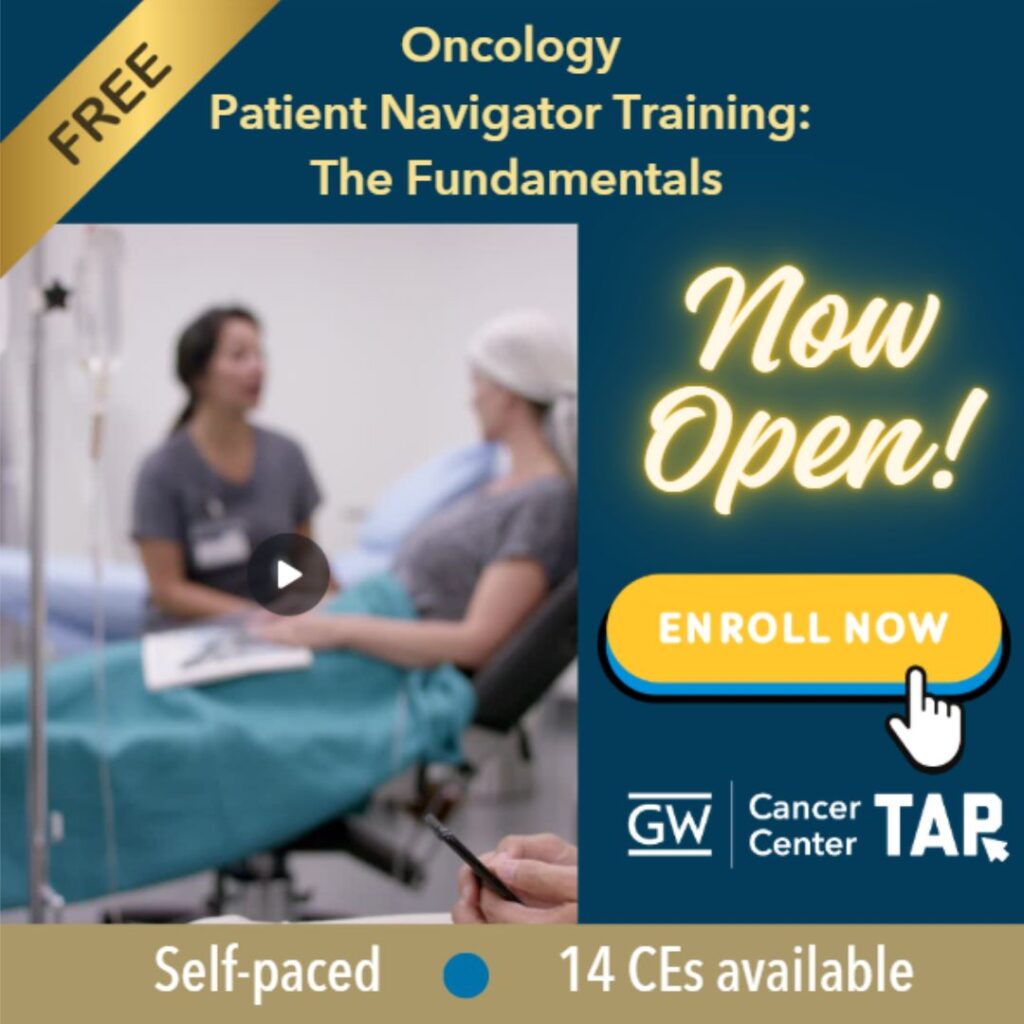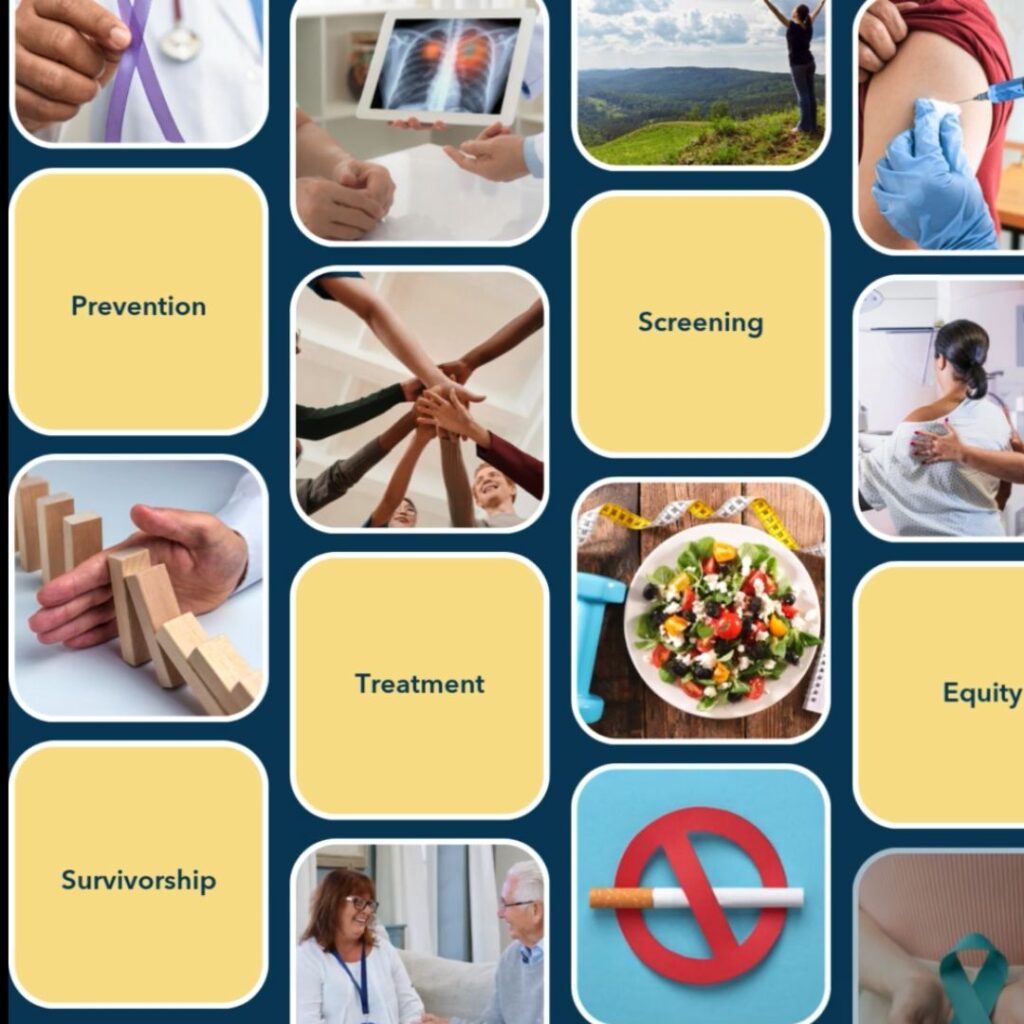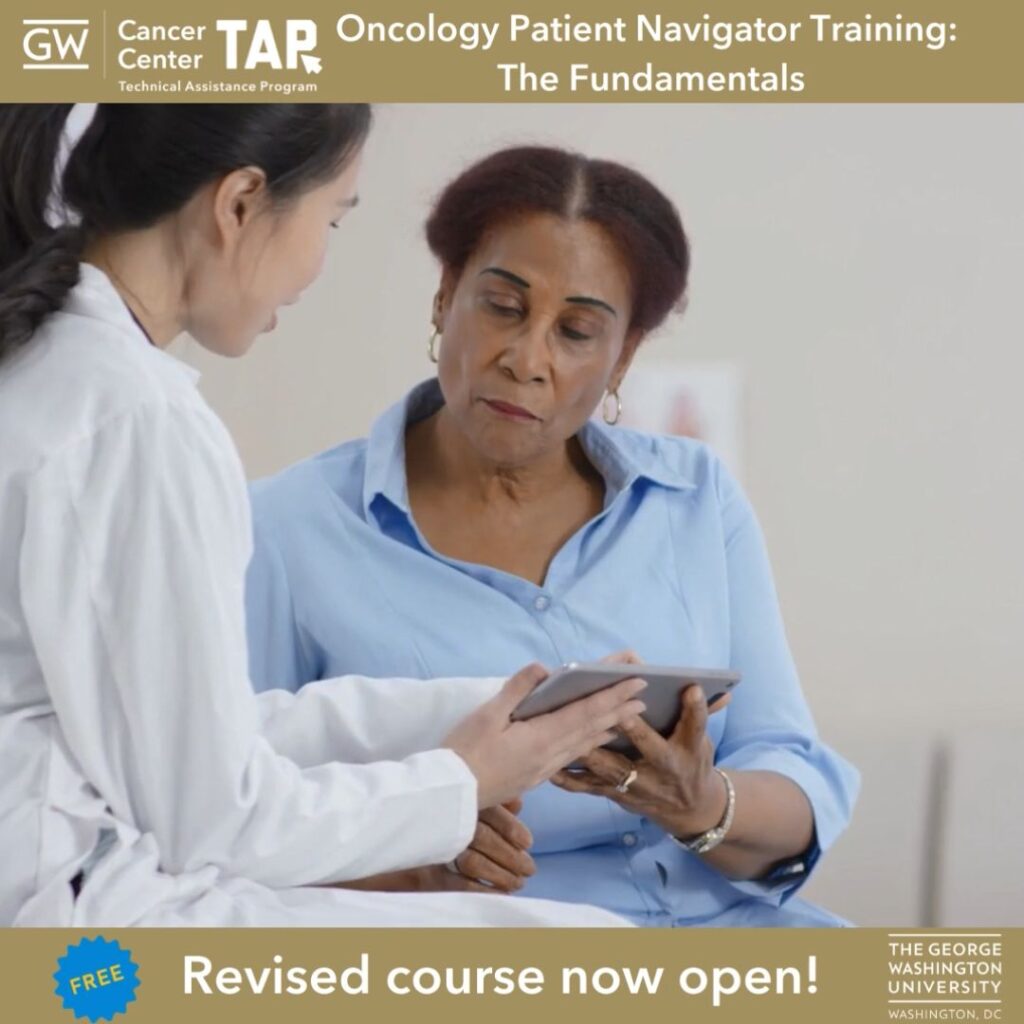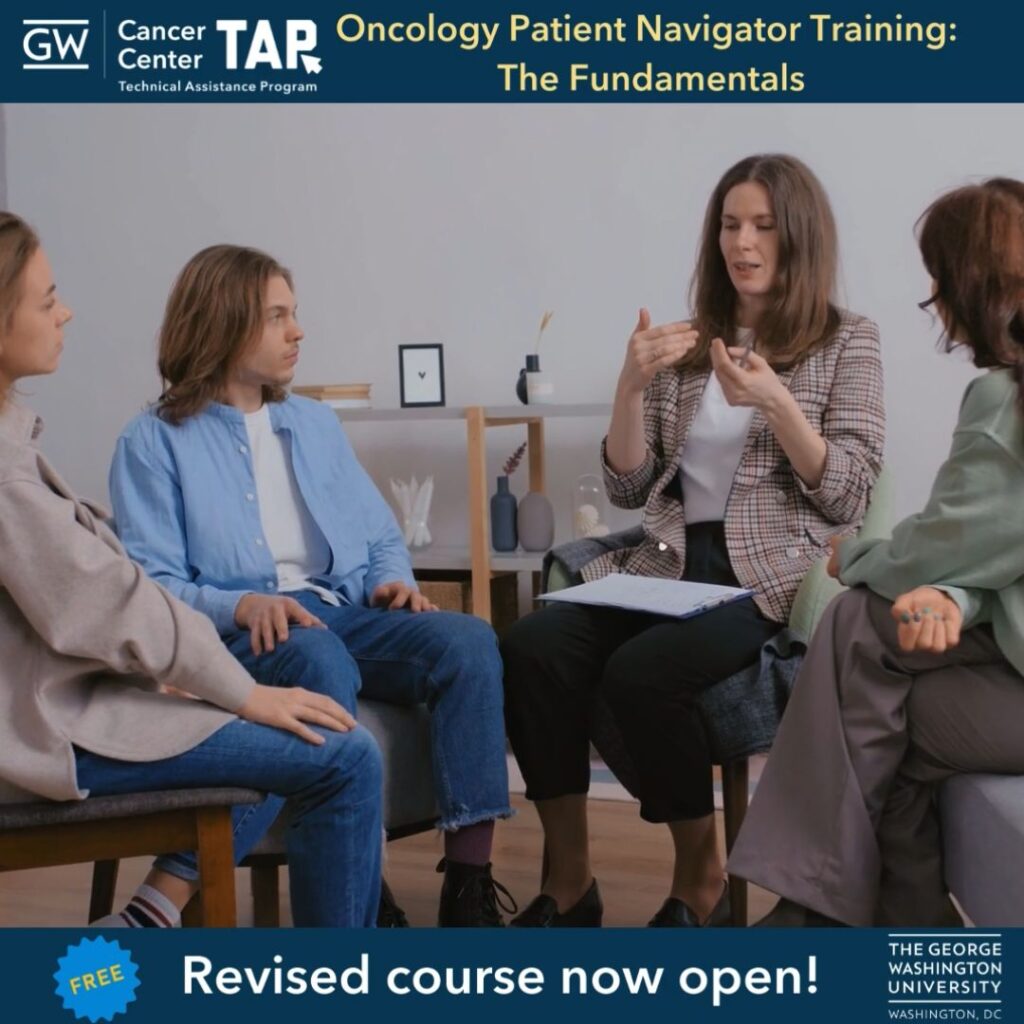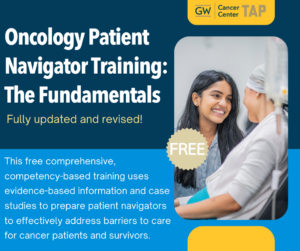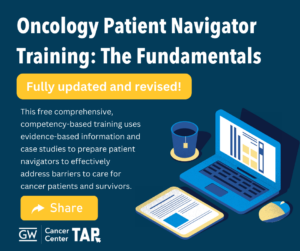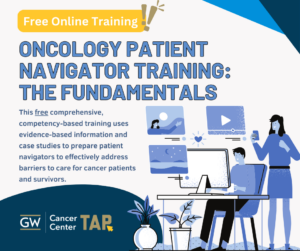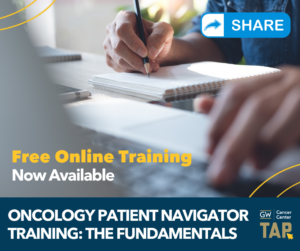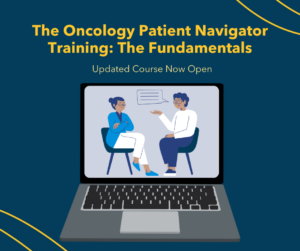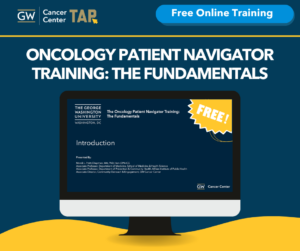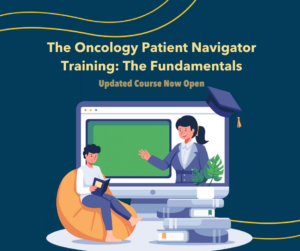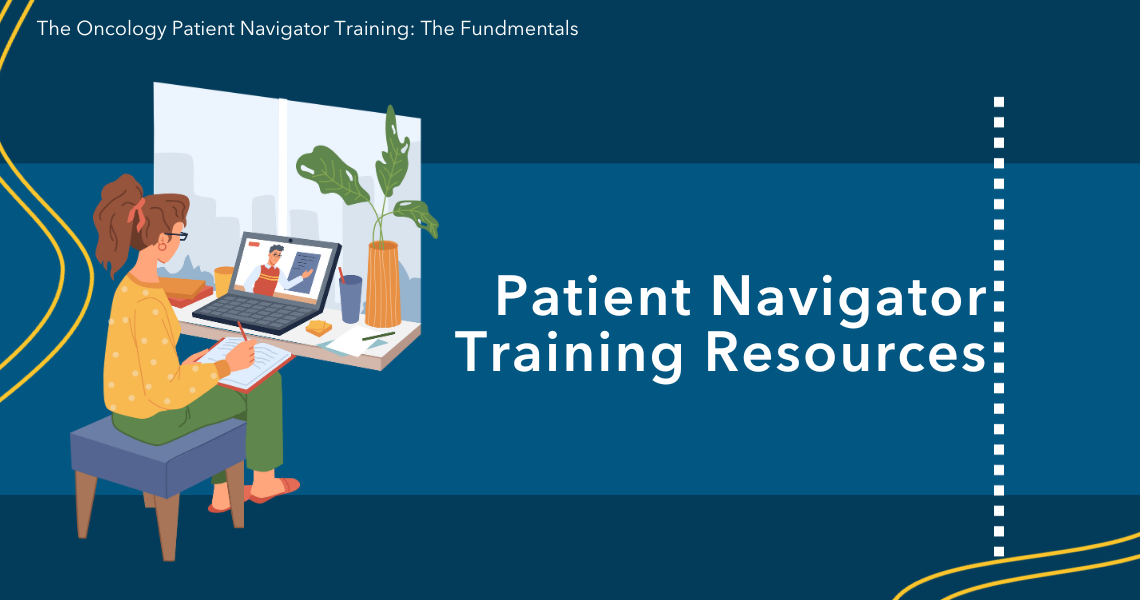 Home/Resources/Patient Navigation
Home/Resources/Patient Navigation
Patient Navigation Training and Resources
The GW Oncology Patient Navigation Training: The Fundamentals, launched in 2015, has provided free training for more than 12,000 patient navigators from over 42 countries. It has been adapted for speakers of Spanish, Portuguese, and American Sign Language. Given major updates to the patient navigation field, GW launched an updated training in 2025. To update the training, current literature was examined, new standards and resources were gathered, and 15 subject matter experts were asked to suggest updates, revisions, and new resource additions. These experts are listed below along with the presenter of each lesson.
Updates to the training included streamlining content, adding new resources, and expanding resources for greater inclusivity. New resources that were included were: the AONN+/ American Cancer Society Navigation Metrics Toolkit, AONN+ CATCH resources, the Oncology Navigation Standards of Professional Practice, the GW Patient Navigation Barriers and Outcomes Tool (PN-BOT), the GW Community Needs Assessment Guide, and the GW Financial Navigation lesson.
The updated GW Oncology Patient Navigation Training: The Fundamentals ensures greater inclusivity to diverse populations, updated evidence and resources critical to the navigation profession, and improvements to the learner experience. The training continues to adhere to CMS training requirements for auxiliary personnel performing PIN services, and can be accessed at bit.ly/PNTraining.
We are able to freely offer this training and these resources thanks to a cooperative agreement from the Centers for Disease Control and Prevention. You are able to download the training materials and adapt them.
You must include the following acknowledgment if materials are adapted:
This content was adapted from the GW Cancer Center the Oncology Patient Navigation Training: The Fundamentals (PI: Pratt-Chapman) developed and maintained by CDC cooperative agreements #NU38DP004972, #5NU58DP006461 and #NU58DP007539. The content added, changed, or adapted by our organization do not necessarily represent the views of the GW Cancer Center or the CDC.
Please visit our frequently asked questions section below for more information.
Oncology Patient Navigator Training Resources
Patient Navigator Training Guide - English
2025 GW Oncology Patient Navigator Training Guide
This guide accompanies the updated training and can be useful for review. The guide offers a reduced and compact overview of each lesson. It does not replace the course, but is offered as a complement to enrich and reinforce key takeaways.
Downloadable Slide Decks from Training
Lesson References and Transcripts
Training Introduction
References | Transcript
Lesson 1: Cancer Basics: Continuum of Cancer Care
References | Transcript
Lesson 2: Medical Terminology
References | Transcript
Lesson 3: What is Patient Navigation & What Does a Navigator do?
References | Transcript
Lesson 4: Team-Based Navigation and Role Delineation
References | Transcript
Lesson 5: US Healthcare System, Payment and Financing
References | Transcript
Lesson 6: Professional Development and Practice-Based Learning
References | Transcript
Lesson 7: Communication with Patients and Caregivers
References | Transcript
Lesson 8: Shared Decision-Making with Patients and Caregivers
References | Transcript
Lesson 9: Patient Advocacy
References | Transcript
Lesson 10: Addressing Barriers to Care with Strengths-based Individual and Community
Assessments
References | Transcript
Lesson 11: Ethics and Patient Rights
References | Transcript
Lesson 12: Program Evaluation and Quality Improvement
References | Transcript
Lesson 13: Clinical Trials
References | Transcript
Lesson 14: Value of Patient Navigation
References | Transcript
Patient Navigator Resources From Training
GW Resources |
||
|
|
The Patient Navigation Barriers and Outcomes Tool (PN-BOT) is freely available and includes worksheets and a barriers list to track specific types of barriers–logistical, insurance-related, financial, or employment. |
|
|
|
This tool is an easy way to ask patient information: name, pronouns, religious beliefs, who they want involved in their care, etc. |
|
|
|
This resource outlines steps for assessing and reducing barriers to care. |
|
|
|
Oncology Patient Navigator Training: The Fundamentals – Competency Alignment |
This tool provides a comparison of all core competencies from leading organizations: CMS, PONT, the National C3 Council for Community Health Workers and the American Cancer Society’s Navigation Job Performance Behaviors, and GW Competencies. |
GW Trainings |
||
|
|
GW offers a free training to support organizational changes at the systems level. The training will help organizations implement quality improvements to advance equitable, accessible and patient-centered cancer care. |
|
|
|
This free training covers implicit bias for clinicians and providers. |
|
|
|
GW offers a free training that provides a comprehensive understanding of CMS guidelines and billing codes for patient navigation services. |
|
|
|
The GW Cancer Survivorship Series is a free training for clinicians to learn about caring for survivors of adult-onset cancer. |
|
External Resources |
||
|
Lesson 1 |
||
|
|
The USPSTF is an independent panel of experts that makes evidence-based recommendations about clinical preventive services, including screenings. |
|
|
|
ACS provides screening recommendations to improve early cancer detection. |
|
|
|
The ACOG also provides screening and early detection guidelines. |
|
|
Lesson 2 |
||
|
|
This resource has more than 7,000 terms related to cancer and medicine. |
|
|
|
This resource will help you become familiar with the names of common drugs and treatment options for people who have cancer. |
|
|
|
This website has a series of self-test questions on roots, prefixes and suffixes. |
|
|
|
This resource offers tools to understand terminology and terms related to drug information |
|
|
This resource provides notable abbreviations and acronyms to help you familiarize yourself. |
||
|
Lesson 4 |
||
|
|
Patient Navigation Job Roles, National Navigation Roundtable |
Published in 2024, this article provides concrete examples of how entry-level, intermediate-level and advanced-level navigators differ and complement each other within a healthcare team. |
|
Lesson 5 |
||
|
|
American College of Surgeons, About Cancer Programs |
Cancer care can be delivered in a variety of settings, use this chart to explore how cancer care programs. |
|
|
To learn more about Medicare and Medicaid, check out this free resource. |
|
|
|
This resource provides an interactive map of ACA Medicaid Expansion by state. |
|
|
Lesson 6 |
||
|
This template helps individuals create and track their own professional development plan. |
||
|
|
The World Health Organization (WHO) provides techniques for managing stress in this guide. |
|
|
Lesson 9 |
||
|
|
Developed by the National Coalition for Cancer Survivorship, the toolbox is a free self-learning audio program designed to help individuals navigate cancer. |
|
|
Lesson 10 |
||
| Coming soon! |
Sample Resource Directory Template |
|
|
Lesson 11 |
||
|
|
The U.S. Department of Health and Human Services (HHS) provides resources to assist healthcare professionals and patients understand HIPAA regulations. |
|
|
Lesson 12 |
||
|
|
The National Cancer Institute spent several years developing a patient experience survey for cancer and provides guidance on how to use the survey. |
|
|
|
The National Institutes of Health developed patient reported outcome measures for evaluation. |
|
|
Lesson 13 |
||
|
|
The National Cancer Institute lets you search through clinical trials and to learn more about clinical trials. |
|
|
|
Center for Information and Study on Clinical Research Participation |
This database allows individuals to search for clinical trials and resources for healthcare professionals to discuss clinical trials. |
|
|
An additional online search tool for clinical trial information. |
|
News and Articles about the Training
- GW Cancer Center: Updated Oncology Patient Navigator Training: The Fundamentals
Revised Training Announcement - Journal of Oncology Navigation & Survivorship : Revisions to GW Oncology Patient Navigation Training Improve Standards to Meet PIN Reimbursement Requirements
- Journal of Oncology Navigation & Survivorship: CMS Payment for Principal Illness Navigation: How Do I Credential My Navigators?
Communication Toolkit to Promote Oncology Patient Navigator Training
You can click here to download a zip file to access all of the tools GW has created for you to help share and promote this training. Or please select one of the resources below and help us promote this updated training.
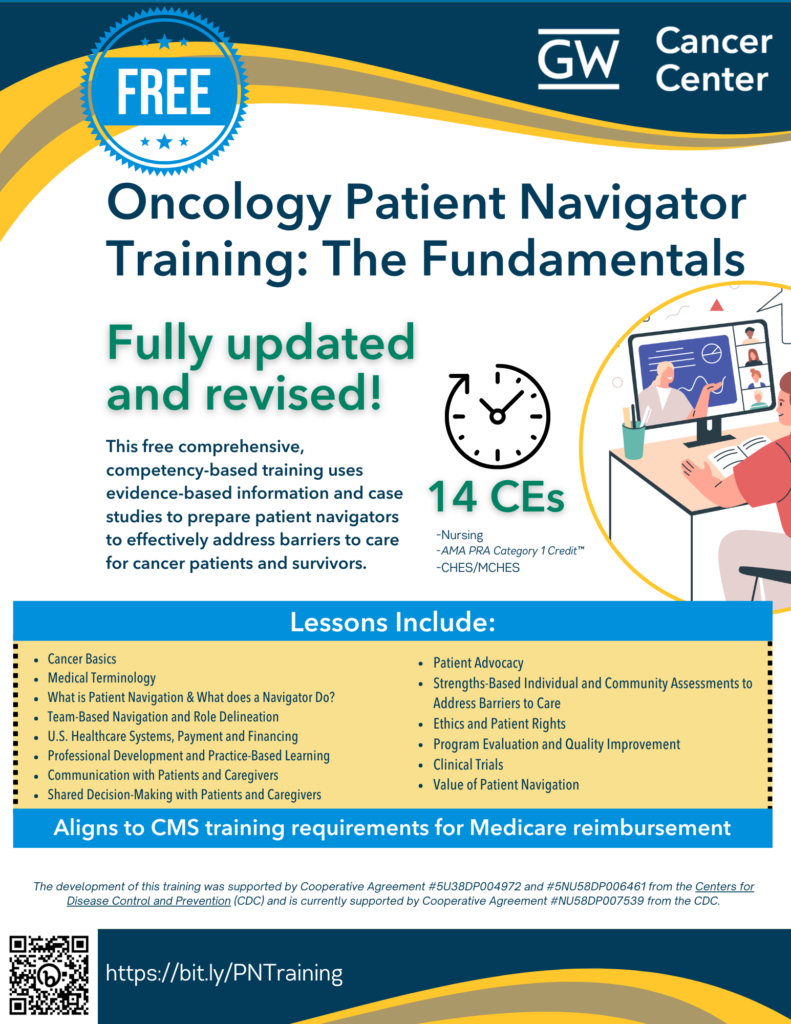
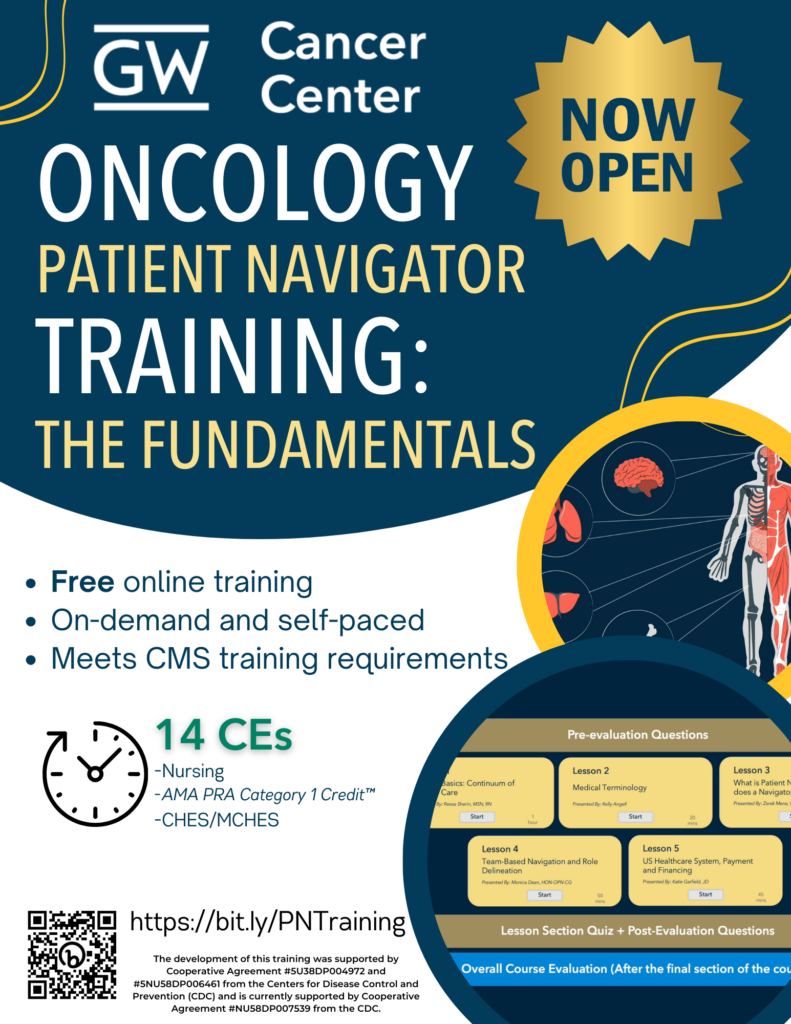
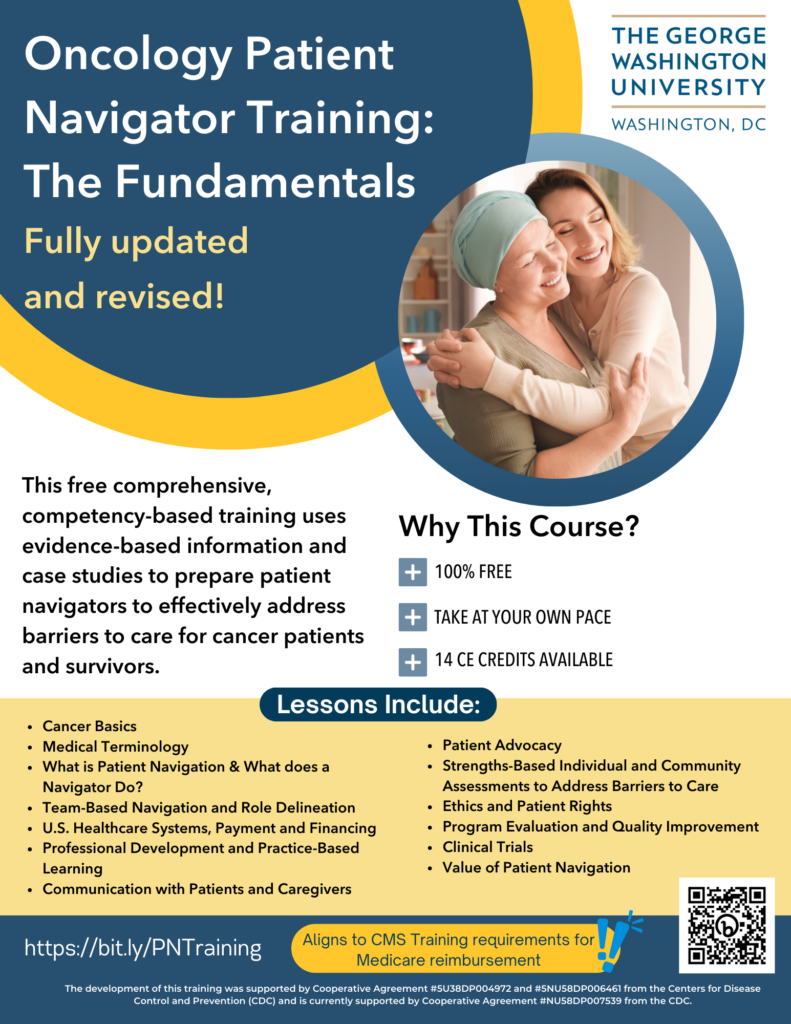
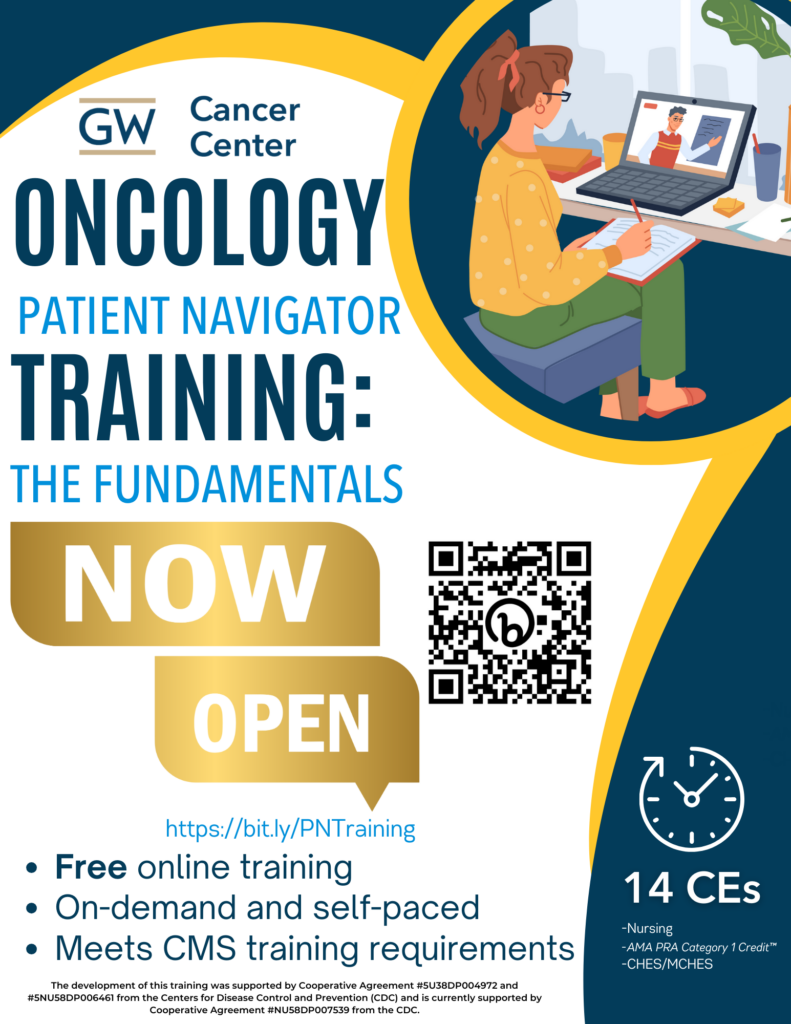
Use this video to promote the release of the revised Oncology Patient Navigator Training.
Use this video to promote the release of the revised Oncology Patient Navigator Training.
Use this video to promote the release of the revised Oncology Patient Navigator Training.
Use this video to promote the release of the revised Oncology Patient Navigator Training.
Social Media Messages and Graphics
Acknowledgements
Developing and revising this training was a year-long collaborative process. Below is the list of individuals who assisted in revising the training and content and a list of the presenters for each lesson.
Subject Matter Experts Included in Training Review
|
Alex Hurst, MHA |
National Council for Mental Wellbeing |
|
Erika Bergeron, MPH |
Gallaudet University |
|
Flint Huffman, MEd |
National LGBT Cancer Network |
|
Janette Merrill, HDA, CHES |
American Society of Clinical Oncology |
|
Jess Quiring, CN-BA, OPN-CG |
Patient Navigation Advisors |
|
Julie McMahon, MPH |
Susan G. Komen |
|
Katie Garfield, JD |
Harvard Law School |
|
Laurie Kierstein, MD, FACS |
American College of Surgeons, Commission on Cancer |
|
Marcela Gaitán, MPH, MA |
Nuestra Voces, National Alliance for Hispanic Health (The Alliance) |
|
Monica Dean, HON-OPN-CG |
Academy of Oncology Nurse and Patient Navigators |
|
Nancy Peña, OPN-CG, CMI |
Navegación de Pacientes Internacional, Inc. (NPI) |
|
Reesa Sherin, MBA, MSN, RN |
Association of Cancer Care Centers |
|
Shonta Chambers, MSW |
Patient Advocate Foundation |
|
Va’a Tofaeono, MBA |
American Samoa Community Cancer Coalitions |
|
Zarek Mena, OPN-CG |
Patient Navigation Advisors |
Lesson Presenters:
| Lesson 1: Cancer Basics: Continuum of Cancer Care Lesson 11: Ethics and Patient Rights |
Reesa Sherin, MSN, RN Association of Cancer Care Centers (ACCC) |
| Lesson 2: Medical Terminology Lesson 4: Team-Based Navigation and Role Delineation Lesson 12: Program Evaluation and Quality Improvement |
Kelly Angell GW Cancer Center |
| Lesson 3: What is Patient Navigation & What Does a Navigator do? Lesson 8: Shared Decision-Making with Patients and Caregivers |
Zarek Mena, OPN-CG Patient Navigation Advisors |
| Lesson 5: US Healthcare System, Payment and Financing | Katie Garfield, JD Harvard Law School |
| Lesson 6: Professional Development and Practice-Based Learning | Nancy Peña Navegación de Pacientes Internacional (NPI) |
| Lesson 7: Communication with Patients and Caregivers | Shonta Chambers, MSW Patient Advocate Foundation |
| Lesson 9: Patient Advocacy Lesson 10: Strengths-based Individual and Community Assessments to Address Barriers to Care |
Jess Quiring, CN-BA, OPN-CG Patient Navigation Advisors |
| Lesson 13: Clinical Trials | Janette Merrill, HDA, CHES American Society of Clinical Oncology |
| Introduction Lesson 14: Value of Patient Navigation |
Mandi Pratt-Chapman, MA, PhD, Hon-OPN-CG GW Cancer Center |
Frequently Asked Questions
What is the cost?
The training is free. There is no cost to take this training and receive a certificate of completion. This is thanks to cooperative agreements #NU38DP004972, #5NU58DP006461 and #NU58DP007539 from the Centers for Disease Control and Prevention.
Does this training meet CMS requirements for navigator reimbursement?
Yes. See the most recent CMS guidelines for PIN code reimbursement here. We also have a free 30-minute online training covering this topic called Special Topics in Patient Navigation: Getting Paid for Navigation.
Does this training certify me as a patient navigator?
Certification and a certificate of completion are different. This training provides a certificate of completion, which fulfills CMS requirements to document training. This training also prepares you for other credentialing, such as the AONN+ OPN-CG examination.
Certification is different from credentialing and licensure. Regulated by states, licensure is required for clinicians and roles like social workers and nurse navigators for example. Community Health Workers (CHWs) require certification in some states, and patient navigators may be specifically listed under those requirements. Certification requires a third-party stamp of approval recognizing that you have achieved a certain level of knowledge to perform your role. Licensure and/or certification is not required to navigate and help patients get through each step of their cancer care journey by reducing barriers to healthcare.
Currently, only limited certification is available through a few national bodies. The National Accreditation Program for Breast Centers has a certification program for breast imaging and breast cancer navigators. The Academy of Oncology Nurse & Patient Navigators (AONN+) created a task force in 2015 and launched a certification process for oncology patient navigators who do not hold a clinical license.The credentials for this certification are OPN-CG, which stands for Oncology Patient Navigator–Certified Generalist. The examination opportunities for OPN-CG credentials are usually offered once a year and can be found here. There is also an Oncology Nurse Navigator credential from AONN+. You can also pay for credentialing from the American Cancer Society through their ACS LION program. None of these credentials are required to document your training in the CMS competency domains.
Most patient navigators have participated in a live or an online training program and are able to document their participation with a certificate of completion. The certificate of completion offered by the GW Oncology Patient Navigator Training: The Fundamentals course demonstrates knowledge acquired by participating in the course and meets the CME training requirements for PIN reimbursement and is aligned to the professional oncology navigation (PONT) standards.
Additional Articles for more information on this topic:
● Journal of Oncology Navigation & Survivorship: Certification v. certification
● Journal of Oncology Navigation & Survivorship: Oncology Patient Navigator−Certified Generalist
● CMS PIN reimbursement does not require any national certification, but your state may require a state-based certification
● Journal of Oncology Navigation & Survivorship: GW Oncology Patient Navigator Training Refresh
How much time will this take?
The estimated completion time for this course is 14 hours.
Can I stop and restart?
Yes! This course is self-paced and the learning management system will keep track of the lesson and section you were last in. We recommend fully completing a section’s video in the lesson you are in before closing the window, but the system will track which section of the lesson you are in.
Can we adapt the content?
Yes. We are able to freely offer this training and offer these resources thanks to a cooperative agreement from the Centers for Disease Control and Prevention. You are able to download the training materials and adapt them.
You must include the following acknowledgment if materials are adapted:
This content was adapted from the GW Cancer Center the Oncology Patient Navigation Training: The Fundamentals (PI: Pratt-Chapman) developed and maintained by CDC cooperative agreements #NU38DP004972, #5NU58DP006461 and #NU58DP007539. The content added, changed, or adapted by our organization do not necessarily represent the views of the GW Cancer Center or the CDC.
Where are your references for the material in your training?
The experts who assisted in content creation and revision assisted to provide references which can be found on each slide of the downloadable power point presentations found on the Patient Navigator Training Resources site and can also be found as a link on each training in the learning management system. To make our references even more accessible, they are posted by lesson on the Patient Navigator Training Resources site.
How can I get a certificate of completion?
Learners who complete all of the required components of the GW Oncology Navigator Training: The Fundamentals Course (Learner Survey, Introduction, all 14 lessons, pre- and post-evaluation assessments and all quizzes with a 70% score or higher) are able to download a PDF of their certificate of completion. The training and certificate are both free.
How much does a certificate of completion cost?
Nothing, it is freely offered upon completion of the course thanks to cooperative agreements #NU38DP004972, #5NU58DP006461 and #NU58DP007539 from the Centers for Disease Control and Prevention.
Who can I contact if I need help with the system?
cancercontrol@gwu.edu
What’s the difference between Credentialing vs. Certification vs. Certificate of Completion
The definitions of these nouns according to the Merriam-Webster Dictionary are below. Certification requires a third-party stamp of approval recognizing that you have achieved a certain level of knowledge to perform your role. In other words, the training vendor should be separate from the certifying body. Certification is different from credentialing and licensure. Regulated by states, licensure is required for clinicians and roles like social workers and nurse navigators for example. However, licensure and/or certification is not required to navigate and help patients get through each step of their cancer care journey by reducing barriers to healthcare.
|
Definitions |
|
|
Credential |
something that gives a title to credit or confidence |
|
Certification |
the act of certifying : the state of being certified |
|
Certificate of Completion |
a document containing a certified statement especially as to the truth of something specifically : a document certifying that one has fulfilled the requirements of and may practice in a field |
Additional Articles for more information on this topic:
● Journal of Oncology Navigation & Survivorship: Certification v. certification
● Journal of Oncology Navigation & Survivorship: Oncology Patient Navigator−Certified Generalist
● CMS PIN reimbursement does not require any national certification, but your state may require a state-based certification
● Journal of Oncology Navigation & Survivorship: GW Oncology Patient Navigator Training Refresh

